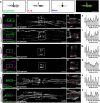An αII Spectrin-Based Cytoskeleton Protects Large-Diameter Myelinated Axons from Degeneration
- PMID: 29038243
- PMCID: PMC5700418
- DOI: 10.1523/JNEUROSCI.2113-17.2017
An αII Spectrin-Based Cytoskeleton Protects Large-Diameter Myelinated Axons from Degeneration
Abstract
Axons must withstand mechanical forces, including tension, torsion, and compression. Spectrins and actin form a periodic cytoskeleton proposed to protect axons against these forces. However, because spectrins also participate in assembly of axon initial segments (AISs) and nodes of Ranvier, it is difficult to uncouple their roles in maintaining axon integrity from their functions at AIS and nodes. To overcome this problem and to determine the importance of spectrin cytoskeletons for axon integrity, we generated mice with αII spectrin-deficient peripheral sensory neurons. The axons of these neurons are very long and exposed to the mechanical forces associated with limb movement; most lack an AIS, and some are unmyelinated and have no nodes. We analyzed αII spectrin-deficient mice of both sexes and found that, in myelinated axons, αII spectrin forms a periodic cytoskeleton with βIV and βII spectrin at nodes of Ranvier and paranodes, respectively, but that loss of αII spectrin disrupts this organization. Avil-cre;Sptan1f/f mice have reduced numbers of nodes, disrupted paranodal junctions, and mislocalized Kv1 K+ channels. We show that the density of nodal βIV spectrin is constant among axons, but the density of nodal αII spectrin increases with axon diameter. Remarkably, Avil-cre;Sptan1f/f mice have intact nociception and small-diameter axons, but severe ataxia due to preferential degeneration of large-diameter myelinated axons. Our results suggest that nodal αII spectrin helps resist the mechanical forces experienced by large-diameter axons, and that αII spectrin-dependent cytoskeletons are also required for assembly of nodes of Ranvier.SIGNIFICANCE STATEMENT A periodic axonal cytoskeleton consisting of actin and spectrin has been proposed to help axons resist the mechanical forces to which they are exposed (e.g., compression, torsion, and stretch). However, until now, no vertebrate animal model has tested the requirement of the spectrin cytoskeleton in maintenance of axon integrity. We demonstrate the role of the periodic spectrin-dependent cytoskeleton in axons and show that loss of αII spectrin from PNS axons causes preferential degeneration of large-diameter myelinated axons. We show that nodal αII spectrin is found at greater densities in large-diameter myelinated axons, suggesting that nodes are particularly vulnerable domains requiring a specialized cytoskeleton to protect against axon degeneration.
Keywords: axon; cytoskeleton; degeneration; node of Ranvier; spectrin.
Copyright © 2017 the authors 0270-6474/17/3711323-12$15.00/0.
Figures








Similar articles
-
αII Spectrin Forms a Periodic Cytoskeleton at the Axon Initial Segment and Is Required for Nervous System Function.J Neurosci. 2017 Nov 22;37(47):11311-11322. doi: 10.1523/JNEUROSCI.2112-17.2017. Epub 2017 Oct 16. J Neurosci. 2017. PMID: 29038240 Free PMC article.
-
alphaII-spectrin is essential for assembly of the nodes of Ranvier in myelinated axons.Curr Biol. 2007 Mar 20;17(6):562-8. doi: 10.1016/j.cub.2007.01.071. Epub 2007 Mar 1. Curr Biol. 2007. PMID: 17331725
-
Nodal β spectrins are required to maintain Na+ channel clustering and axon integrity.Elife. 2020 Feb 13;9:e52378. doi: 10.7554/eLife.52378. Elife. 2020. PMID: 32052742 Free PMC article.
-
Cytoskeletal control of axon domain assembly and function.Curr Opin Neurobiol. 2016 Aug;39:116-21. doi: 10.1016/j.conb.2016.05.001. Epub 2016 May 18. Curr Opin Neurobiol. 2016. PMID: 27203619 Free PMC article. Review.
-
Spectrin and ankyrin-based cytoskeletons at polarized domains in myelinated axons.Exp Biol Med (Maywood). 2008 Apr;233(4):394-400. doi: 10.3181/0709-MR-243. Exp Biol Med (Maywood). 2008. PMID: 18367627 Review.
Cited by
-
Glial βII Spectrin Contributes to Paranode Formation and Maintenance.J Neurosci. 2018 Jul 4;38(27):6063-6075. doi: 10.1523/JNEUROSCI.3647-17.2018. Epub 2018 May 31. J Neurosci. 2018. PMID: 29853631 Free PMC article.
-
Disease resistance in coral is mediated by distinct adaptive and plastic gene expression profiles.Sci Adv. 2022 Sep 30;8(39):eabo6153. doi: 10.1126/sciadv.abo6153. Epub 2022 Sep 30. Sci Adv. 2022. PMID: 36179017 Free PMC article.
-
Periodic subcellular structures undergo long-range synchronized reorganization during C. elegans epidermal development.J Cell Sci. 2020 Nov 3;133(21):jcs246793. doi: 10.1242/jcs.246793. J Cell Sci. 2020. PMID: 33033182 Free PMC article.
-
Visualizing and discovering cellular structures with super-resolution microscopy.Science. 2018 Aug 31;361(6405):880-887. doi: 10.1126/science.aau1044. Epub 2018 Aug 30. Science. 2018. PMID: 30166485 Free PMC article. Review.
-
Cargo hold and delivery: Ankyrins, spectrins, and their functional patterning of neurons.Cytoskeleton (Hoboken). 2020 Mar;77(3-4):129-148. doi: 10.1002/cm.21602. Epub 2020 Feb 14. Cytoskeleton (Hoboken). 2020. PMID: 32034889 Free PMC article. Review.
References
-
- Berghs S, Aggujaro D, Dirkx R Jr, Maksimova E, Stabach P, Hermel JM, Zhang JP, Philbrick W, Slepnev V, Ort T, Solimena M (2000) betaIV spectrin, a new spectrin localized at axon initial segments and nodes of Ranvier in the central and peripheral nervous system. J Cell Biol 151:985–1002. 10.1083/jcb.151.5.985 - DOI - PMC - PubMed
-
- Bhat MA, Rios JC, Lu Y, Garcia-Fresco GP, Ching W, St Martin M, Li J, Einheber S, Chesler M, Rosenbluth J, Salzer JL, Bellen HJ (2001) Axon-glia interactions and the domain organization of myelinated axons requires neurexin IV/Caspr/Paranodin. Neuron 30:369–383. 10.1016/S0896-6273(01)00294-X - DOI - PubMed
Publication types
MeSH terms
Substances
Grants and funding
LinkOut - more resources
Full Text Sources
Other Literature Sources
Molecular Biology Databases
